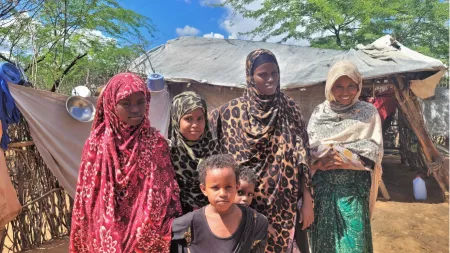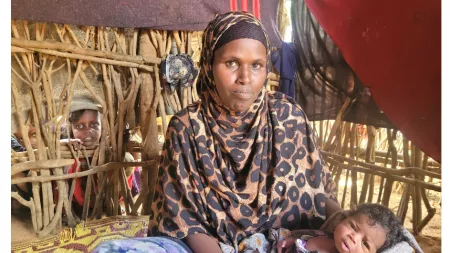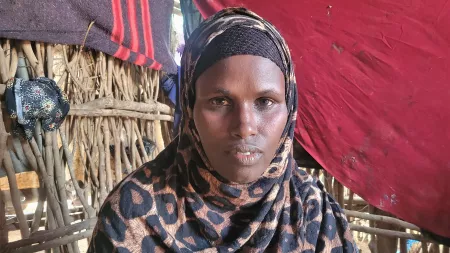Four girls are sleeping huddled closely together on the bed under the white mosquito net when suddenly a loud crack wakes them up. The back wall of their clay hut is falling slowly towards them. Water is breaking through a large hole in the wall. The girls start screaming when the water hits them. Their mother, Saruro, comes running, grabs her children and they run to find shelter in a neighbor’s hut. In seconds their hut is flooded and the wheat sacks standing beside the bed are destroyed. That is their food for the next month.
The next morning the family checks the status of their home. The water destroyed everything inside and the hut is unstable. That night they sleep on the floor in a hut made out of sticks instead of clay. There, they are more vulnerable to floods, but the roof is more stable. “I feel unsafe here. I don’t know if tomorrow the roof will collapse on top of my children’s heads,” says Saruro Absuhhatti Dahir, 36, mother of nine. A few days ago, the hut in which Saruro normally sleeps with her husband also collapsed.

Saruro arrived in the Kenyan refugee camp, Dadaab, in 1992 when she was three years old. “My family fled Somalia when the war broke out and there was a lot of killing. I do not remember Somalia. Dadaab feels like my home because I have lived here for over 30 years,” Saruro explains. She went to school here, met her husband, married, and gave birth to nine children. The eldest is 18 years old and the youngest is 10 days old. “I just gave birth in the hospital for refugees. I went there because my baby then will automatically be registered. If I would have birthed her here at home, she would not receive any humanitarian aid,” explains the mother.
“We lack essential services and cannot cover our basic needs. We have nothing to sleep on anymore because the bed was destroyed in the floods. I use a thin mat and a mosquito net to sleep on the floor,” Saruro describes pointing to the mat she is sitting on. It is hotter inside the hut than outside in the sun. The air is heavy and stifling. The sticks that hold the hut are loosely tied together so that a little air comes through the holes. Two of her smaller children are looking inside through the holes. Even though heavy rains and floods challenge the family, drinking water is scarce, as the next water tap is far away. “There is not enough drinking water for my family. We do not eat three meals a day. We hardly have enough for one meal a day,” Saruro continues.

The current heavy rains have also flooded the latrines. The one closest to her has collapsed. “We also didn’t have any soap between January and March. CARE has stepped in and given us some soap and jerricans, so that we now can transport drinking water and wash ourselves.” Saruro’s family has little income. Her husband takes care of some goats for a local farmer. CARE has been supporting families since the start of the camps and has faced many challenges over the three decades. Dwindling funding and extreme weather such as flooding and drought, are currently of high concern.
When asked what she wishes for, she looks down at her 10-day-old daughter before she answers: “My wish is, that my family and myself have good shelter, a functioning latrine, and more soap.” She doesn’t have any expectations for a different future. “We lost hope. We have been here too long,” she continues and readjusts her sitting position on her sleeping mat while she starts breastfeeding her daughter under her shawl. If she could wish for anything in the world, Saruro expresses: “My biggest wish is that one day I will see the modern world just once.”
In order to support Saruro and other families, CARE calls upon the international community to take decisive actions in supporting the refugees in Dadaab.
